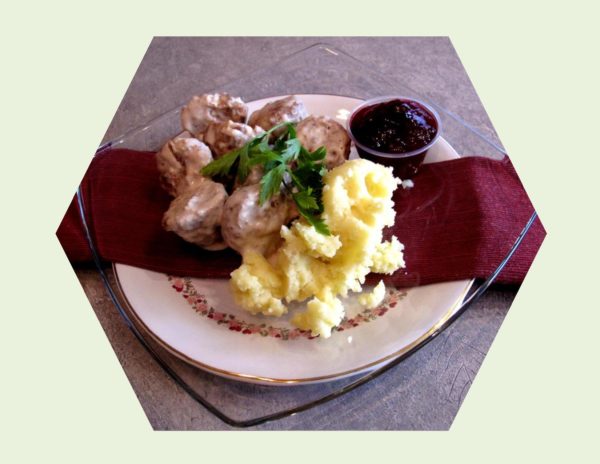With New Years Eve gatherings fast approaching, these little gems come to mind in the form of hors ‘d’ oeuvres. Of course, they are always great for a main dish as well.
The Swedish word for meatball, ‘Kottbullar’, first appeared in print around 1754. They are traditional Swedish ‘old-world’ fare at Smorgasbords and other festive occasions. Initially Swedish meatballs were only enjoyed by upper class Swedes but the increased availability of wood stoves and meat grinders in the 1850’s made meatballs accessible to the middle class as well. In northern Scandinavian countries beef was considered a luxury item, which meant meatballs were highly prized.
The meat content can vary based on geography. In southern Sweden, they are most often a 50/50 mix of beef and pork whereas further north in Sweden 70/30 of beef to pork is typical. Likely other options would be veal, venison, lamb or moose. Size-wise, they are smaller than those of Italy or Germany, typically not larger than a golf ball or smaller than 3/4″(2.5 cm) across.
The cream gravy (sauce) and spices play a big part in the taste of this dish, traditionally served with lingonberry preserves, mashed potatoes and pickled cucumber salad. The ‘pressed cucumber’, as it is called, provides some crunch, saltiness and acidity to the sweet creaminess of the rest of the meal.
In America, Swedish meatballs were very popular in the beginning of the 20th century and again in the 1950’s-1960′.
Brion and I have always enjoyed these tasty little meatballs so we are having them as our main course meal today.

| Servings |
depending on the size you make
|
- 6 Tbsp onion, finely chopped
- 1 Tbsp margarine
- 6 Tbsp breadcrumbs, dry
- 2 cups 1/2 & 1/2 cream
- 2 eggs
- 400 grams beef
- 400 grams veal
- 200 grams pork
- 4 small potatoes, boiled, cold & mashed
- 1 Tbsp salt
- white pepper, nutmeg, & ginger TO TASTE
- 1/8 cup margarine
- 1/8 cup flour
- 1 cup 1/2 & 1/2 cream
- 1 cup beef broth
- 1/2 tsp salt
- 1/2 tsp soy sauce
- 1/8 tsp white pepper
Ingredients
Meatballs
Cream Sauce
|

|
- Soak breadcrumbs in 2 cups of 1/2 & 1/2 cream. Fry onion in margarine. Combine all meatball ingredients & mix well. Shape into 1-inch balls. Preheat broiler to a high setting.
- Place meatballs in a large baking dish, allowing a bit of space in between each one. Broil about 4" (10 cm) from heat until the tops are browned nicely. Watch carefully to avoid burning. Set oven to bake & reduce temperature to 300 F. Bake until meatballs are cooked through, depending on their size. If it seems they are getting too brown, cover lightly with a piece of foil to finish baking.
- In a small saucepan, cook margarine & flour until bubbly. Slowly add broth & cream; boil for a FEW minutes, add soy, salt & pepper. Pour over hot meatballs.
- This recipe can easily be made in whatever amount you need but I find making the whole thing & freezing them in various amounts works great for quick future meals. Freezing them without any sauce also gives you the option to adapt them to other types of meals.











